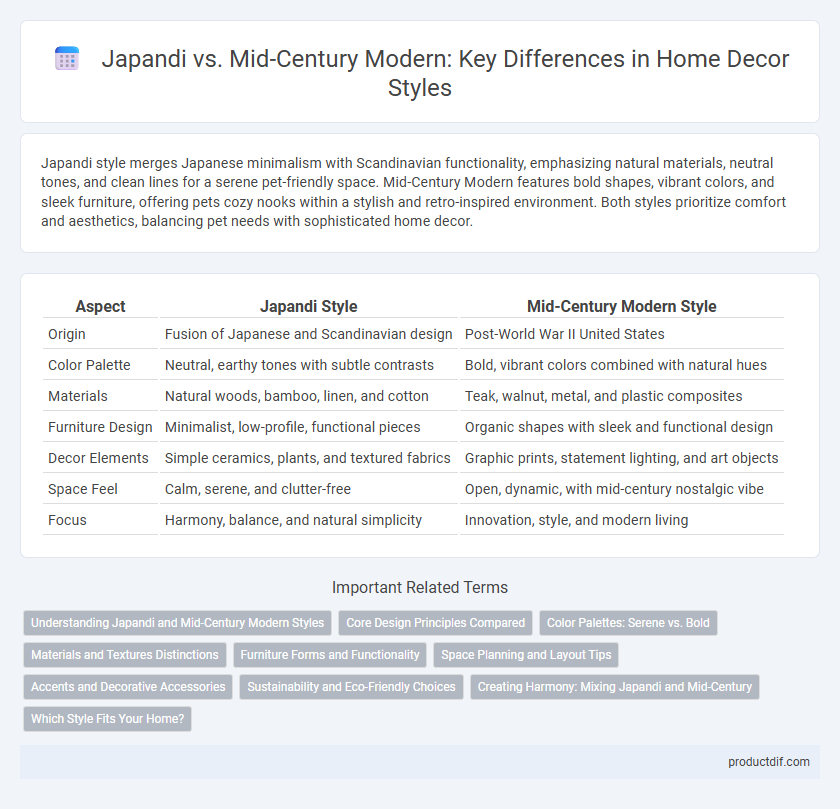Japandi style merges Japanese minimalism with Scandinavian functionality, emphasizing natural materials, neutral tones, and clean lines for a serene pet-friendly space. Mid-Century Modern features bold shapes, vibrant colors, and sleek furniture, offering pets cozy nooks within a stylish and retro-inspired environment. Both styles prioritize comfort and aesthetics, balancing pet needs with sophisticated home decor.
Table of Comparison
| Aspect | Japandi Style | Mid-Century Modern Style |
|---|---|---|
| Origin | Fusion of Japanese and Scandinavian design | Post-World War II United States |
| Color Palette | Neutral, earthy tones with subtle contrasts | Bold, vibrant colors combined with natural hues |
| Materials | Natural woods, bamboo, linen, and cotton | Teak, walnut, metal, and plastic composites |
| Furniture Design | Minimalist, low-profile, functional pieces | Organic shapes with sleek and functional design |
| Decor Elements | Simple ceramics, plants, and textured fabrics | Graphic prints, statement lighting, and art objects |
| Space Feel | Calm, serene, and clutter-free | Open, dynamic, with mid-century nostalgic vibe |
| Focus | Harmony, balance, and natural simplicity | Innovation, style, and modern living |
Understanding Japandi and Mid-Century Modern Styles
Japandi blends Japanese minimalism with Scandinavian functionality, emphasizing natural materials, neutral tones, and clean lines to create serene, clutter-free spaces. Mid-Century Modern style highlights organic shapes, bold colors, and sleek wood furniture inspired by the 1940s-1960s design movement, promoting both form and function. Understanding these styles involves recognizing Japandi's focus on simplicity and harmony versus Mid-Century Modern's celebration of innovation and vibrant aesthetics.
Core Design Principles Compared
Japandi design emphasizes minimalism, natural materials, and a harmonious blend of Japanese wabi-sabi aesthetics with Scandinavian functionality, creating serene and clutter-free spaces. Mid-Century Modern focuses on clean lines, organic curves, and innovative materials that highlight functionality while adding a retro-futuristic charm. Both styles prioritize simplicity and functionality but differ in their cultural origins and material choices, with Japandi favoring warmth and natural textures and Mid-Century Modern embracing bold forms and sleek finishes.
Color Palettes: Serene vs. Bold
Japandi color palettes emphasize muted, natural tones such as soft beige, warm taupe, and gentle gray, fostering a serene and calming atmosphere. Mid-Century Modern embraces bold, vibrant colors like mustard yellow, teal, and burnt orange, creating energetic and visually striking spaces. These distinct palettes reflect Japandi's minimalist tranquility versus Mid-Century Modern's dynamic expressiveness.
Materials and Textures Distinctions
Japandi design emphasizes natural materials like light woods, bamboo, and linen, creating a soft, tactile atmosphere with smooth and raw textures that evoke minimalism and warmth. Mid-Century Modern features richer materials such as teak, walnut, and leather, offering a mix of sleek, polished surfaces and textured fabrics like tweed or wool for a bold, retro aesthetic. The contrast between Japandi's organic simplicity and Mid-Century Modern's refined, eclectic textures defines their unique sensory experiences in home decor.
Furniture Forms and Functionality
Japandi furniture emphasizes clean lines, natural materials, and multi-functional pieces that prioritize simplicity and practicality, reflecting a blend of Japanese minimalism and Scandinavian coziness. Mid-Century Modern furniture features sleek, organic shapes with a focus on innovative materials like molded plywood and metal, balancing aesthetics with functional design tailored to mid-20th century living. Both styles highlight ergonomic comfort but differ in their approach: Japandi favors subtle harmony and modular adaptability, while Mid-Century Modern showcases bold, sculptural forms and iconic statement pieces.
Space Planning and Layout Tips
Japandi emphasizes minimalism with open, clutter-free layouts that maximize natural light and create serene, functional spaces using low-profile furniture and neutral palettes. Mid-Century Modern favors clean lines and functional forms, incorporating statement pieces like iconic chairs and geometric rugs to define zones within open-plan rooms. Both styles prioritize balanced spatial flow, but Japandi leans towards simplicity and calm, while Mid-Century Modern highlights bold accents and structured arrangements.
Accents and Decorative Accessories
Japandi style features minimalist accents with natural materials such as bamboo, rattan, and linen, emphasizing neutral tones and handcrafted pottery to create a serene atmosphere. Mid-Century Modern decor incorporates bold geometric patterns, vibrant colors, and sleek metal or wooden accessories, including starburst clocks and abstract art sculptures. Both styles utilize decorative accessories to enhance the space, with Japandi leaning towards subtle, nature-inspired elements and Mid-Century Modern favoring statement pieces that emphasize form and function.
Sustainability and Eco-Friendly Choices
Japandi and Mid-Century Modern styles emphasize sustainability through the use of natural, renewable materials like bamboo, teak, and reclaimed wood, promoting eco-friendly home decor choices. Japandi prioritizes minimalism and functionality, reducing waste and encouraging mindful consumption with its Scandinavian-Japanese fusion. Mid-Century Modern highlights timeless design and durability, supporting long-lasting furniture that minimizes environmental impact over time.
Creating Harmony: Mixing Japandi and Mid-Century
Blending Japandi and Mid-Century Modern styles creates a harmonious home decor that balances minimalism with warmth. Japandi's natural materials and muted tones complement Mid-Century Modern's bold shapes and organic wood finishes, fostering a cohesive and inviting atmosphere. Thoughtful integration of clean lines, functional furniture, and textured textiles enhances both aesthetics while promoting tranquility and timeless elegance.
Which Style Fits Your Home?
Japandi combines Japanese minimalism with Scandinavian functionality, emphasizing natural materials, muted colors, and uncluttered spaces, ideal for those seeking a calm, serene environment. Mid-Century Modern features clean lines, organic shapes, and bold colors, perfect for homes that embrace retro charm and vibrant design elements. Choose Japandi if you prefer simplicity and tranquility, while Mid-Century Modern suits you if you want a lively, stylish atmosphere with a vintage touch.
Japandi vs Mid-Century Modern Infographic

 productdif.com
productdif.com